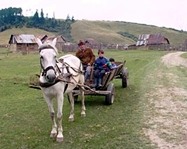Among ethnic groups living in Poland for centuries, Roma are an element that is most exotic and intriguing, and yet least known.
Jerzy Ficowski, Cyganie w Polsce (Roma in Poland), 1989
At best, the Polish attitude towards the "Cyganie" (Roma) is: "I like them as long as they don't live next door." A much more frequent stance is that of open hostility: Roma are associated with theft, filth and deceit, and not just by extreme right-wingers who, given the chance, would burn Romany houses, a situation that occurred in 1998 by so-called ordinary citizens.
One time, when a Roma man filed a complaint against some discriminatory behavior directed towards him, the policeman taking a note of the complaint added a telling remark: the person filing this complaint is a Rom. The policeman failed to mention that the complainant was not only a Rom but also a Polish citizen. In the Polish language, the verb cyganić means "to cheat."
Cultivation of a culture
Despite ethnic antagonisms, Roma were able to cultivate their nomadic lifestyle prior to the Second World War. After 1945 and the Roma's "forgotten Holocaust"[1] they still managed to retain their nomadic routine until 1964 (except for the highland Roma, or Roma from the Podkarpacie region who had settled long before).
 Following the war, the new Polish authorities exerted a strong policy to force Roma to settle and take jobs. These attempts half-succeeded. Roma would settle, but they formed enclosed communities. Many of them would still engage in a lifestyle that bore at least some features of their previous roaming nature: instead of getting "decent" jobs they would become traveling musicians and petty craftsmen visiting town after town trying to sell their artifacts.
Following the war, the new Polish authorities exerted a strong policy to force Roma to settle and take jobs. These attempts half-succeeded. Roma would settle, but they formed enclosed communities. Many of them would still engage in a lifestyle that bore at least some features of their previous roaming nature: instead of getting "decent" jobs they would become traveling musicians and petty craftsmen visiting town after town trying to sell their artifacts.
With their travels followed an invariable atmosphere of resentment. In the towns of Konin in 1981 and Mława ten years later, this resentment almost culminated in drawing up of regular pogroms.
Changing attitudes
Recently, however, there have been signs of growing positive interest in Roma history and culture. Ideas of multi-ethnicity are becoming more popular amongst the educated, and from them emanate ideas that penetrate other sections of society.
 This year two important books, aimed at eradicating the mutual stereotypes and prejudices between the Poles and the Roma, were released: a book by Lidia Ostałowska entitled Cygan to Cygan (A Gypsy is a Gypsy)[2] and a photo album from Piotr Wójcik entitled Cyganie z obu stron Karpat (Gypsies from both sides of the Karpaty).[3] Both publications attempt to reverse prevailing attitudes towards the Roma making them all the more interesting.
This year two important books, aimed at eradicating the mutual stereotypes and prejudices between the Poles and the Roma, were released: a book by Lidia Ostałowska entitled Cygan to Cygan (A Gypsy is a Gypsy)[2] and a photo album from Piotr Wójcik entitled Cyganie z obu stron Karpat (Gypsies from both sides of the Karpaty).[3] Both publications attempt to reverse prevailing attitudes towards the Roma making them all the more interesting.
What is striking at the first glance of Wójcik's photographs or after reading one of Ostałowska's reports is that they try not to take any stance. Taking a stance on Roma issues has seemingly been a must, ever since someone began writing about them. Not this time, however. Neither author engages in tear-jerking descriptions of the Roma's poor fate, marked by discrimination and hatred. Nor do they try to prove that Roma are—by nature—a filthy nation of thieves.
Instead, they show that Roma do exist and are an ordinary part of Poland's landscape, just as anybody else. No doubt, there are differences, but this is neither an excuse for discrimination nor a glorification of differentiation. As David Warszawski wrote in Gazeta Wyborcza, "Ostałowska's stories and Wójcik's pictures are not really about Roma. They are about people who are Roma... The most obvious thing, that is the Roma-ness of Roma, becomes a mere costume. And the story here is about people, not the costume."[4] Both books were published to wide acclaim and certainly evoked an interest in Roma.

|
Gazda works with Roma from Zabrze, organizes dance workshops for them, shows Roma children their roots to preserve the fading memory of Roma tabory (the manner in which Roma used to travel around in horse carriages). "I'm not trying to flatter them or impose my presence. We just cooperate," says Gazda.
Roma have known Poles for centuries and Poles have seen Roma around them for an equal amount of time, yet there is little they know about them. Cooperation is seen as the way to discover what Roma have in store for us all.
Wojtek Kość, 23 November 2000
Photos courtesy of Oltiţa Stiuj, Monitorul de Braşov
Moving on:
- Archive of articles on Poland in CER
- Browse through the CER eBookstore for electronic books
- Buy English-language books on Poland through CER
- Return to CER front page
Footnotes:
2. Lidia Ostałowska, Cygan to Cygan ( A Gypsy is a Gypsy). Twój Styl Publishing House, Warsaw 2000. Available at Merlin Internet Bookshop.
4. Dawid Warszawski, Cyganie są (Gypsies are here). "Gazeta Wyborcza," Vol 255/2000.



